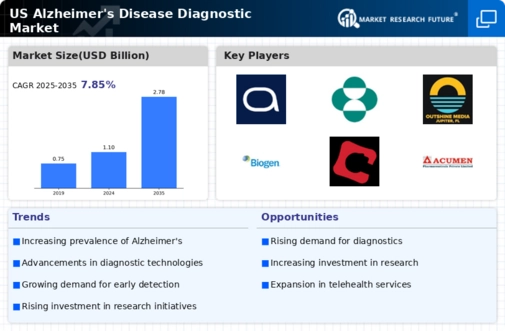The US Alzheimer's Disease Diagnostic Market is an evolving landscape characterized by significant advancements in technology and increasing recognition of the disease's impact on public health. The rise in the aging population, coupled with higher awareness and more sophisticated diagnostic methodologies, has led to a competitive environment where numerous players strive to establish their presence. Companies in this sector are engaged in developing innovative tools and solutions, such as biomarkers, imaging techniques, and cost-effective assessment systems, aimed at improving early detection and diagnosis of Alzheimer's disease.
This market is shaped not just by product offerings but also by investments in research and development, strategic collaborations, and regulatory approvals. As newer diagnostic methods emerge, competition intensifies, compelling companies to differentiate their technologies and leverage partnerships to enhance their market positioning. AbbVie has carved a niche in the US Alzheimer's Disease Diagnostic Market by focusing on the integration of advanced biomarker assays and diagnostic imaging solutions. The company leverages its strong research capabilities and extensive portfolio to introduce products that address the pressing needs of early Alzheimer's detection.
AbbVie’s approach involves collaborating with research institutions and other stakeholders to drive innovation. Their well-established brand recognition and commitment to quality solutions enhance their competitive edge in a rapidly evolving market. The company's robust pipeline also indicates a forward-thinking strategy that aligns with long-term health trends, enabling them to remain at the forefront of Alzheimer's diagnostics in the United States. Merck stands as a key player in the US Alzheimer's Disease Diagnostic Market through its commitment to innovative research and comprehensive diagnostic tools.
The company focuses on developing targeted therapies that are connected with advanced diagnostics for Alzheimer's disease, enabling better clinical outcomes. Merck's key products often encompass a blend of pharmacological treatments and diagnostic tests that are designed to work in synergy, offering holistic management options for patients. In recent years, Merck has engaged in strategic mergers and acquisitions tailored to enhance its diagnostic capabilities and expand its market presence in the US This strategy not only strengthens its product lineup but also facilitates access to cutting-edge technologies and expertise, reinforcing Merck's role as a leader in the competitive landscape of Alzheimer's disease diagnostics.




















Leave a Comment